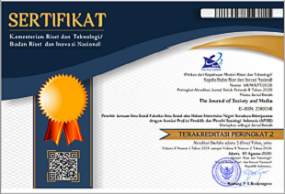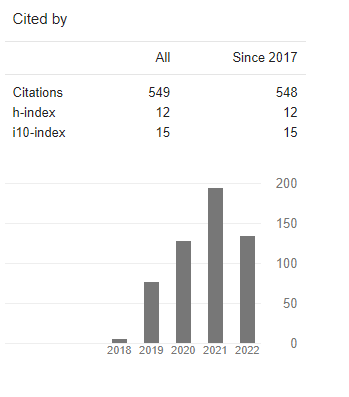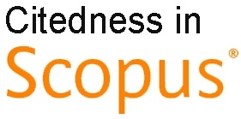The Influences of Facebook on High School Students Pattern of Social Life: The Case of Harar City
DOI:
https://doi.org/10.26740/jsm.v4n1.p66-90Keywords:
facebook, interaction, social lifeAbstract
In todays world, it seems that social media and youngsters are destined for each other as both are young, fast paced and ever changing. It has become very challenging to cultivate and socialize youngsters with patterned social norms due to the influences of media like television and Facebook. Educators are challenged more seriously than ever before to teach youngster, as students are using Facebook at school and home. The aim of this study was to investigate the multifaceted influences of Facebook on youth's pattern of social life. Both quantitative and qualitative methods of data collection were employed to collect the data. Questionnaire, interview schedule and key informant interviews were data collection tools used to collect the quatitative and qualitative data respectively. The study founded that, Facebook is a social medium that discourages social bond in one way and encourages in the other way. By networking peers online, it enhances strong affiliation among Facebook friends while by letting them ignore people who are nearby, it debilitates face to face to face personal interactions. Anonymous Facebook users can meet in ˜chat rooms and discuss on topics of their choices with the person they do not know before and this type of electronic friendship and interaction may grow up and leads to virtual physical face-to-face contacts. Facebook is therefore, a platform for youths to discuss and interact on the issues of mutual curiosity which could enhance and promote synchronization of friends on the one side and inflammatory rhetoric conflicts on the other side, which implies the inevitable and multidimensional influences of Facebook on the youths social life
References
Achmad, Zainal Abidin, and Rachma Ida. 2018. œEtnografi Virtual Sebagai Teknik Pengumpulan Data Dan Metode Penelitian. The Journal of Society and Media 2(2):13045.
Al-Dheleai, Yahya M., and Zaidatun Tasir. 2017. œUsing Facebook for the Purpose of Students Interaction and Its Correlation with Students Academic Performance. Turkish Online Journal of Educational Technology - TOJET 16(4):17078.
Al-Zeaud, H. A. 2014. œPublic Debt and Economic Growth: An Empirical Assessment. European Scientific Journal 10(4):14858.
Anderson, C. A., and B. J. Bushman. 2001. œEffects of Violent Video Games on Aggressive Behavior, Aggressive Cognition, Aggressive Affect, Physiological Arousal, and Pro-Social Behavior.A Meta-Analytic Review of the Scientific Literature. Psychological Science 12:35359.
Baym, N.K, Y.B. Zhang, and M. Lin. 2004. œSocial Interactions across Media: Interpersonal Communication on the Internet, Face-to-Face,and the Telephone. New Media & Society Vol. 6(3):299318.
Boyd, D. 2007. Why Youth (Heart) Social Network Sites: The Role of Networked Publics in Teenage Social Life. Cambridge: MA, MIT Press.
Boyd, D., and N. Ellison. 2007. œSocial Network Sites: Definition, History, and Scholarship. Journal of Computer Mediated Communication 13(1):111.
Damanik, Erond L. 2018. œWhatsapp Dan Pemilih Pemula Di Kota Medan: Partisipasi Politik Era Demokrasi Digital Pada Pemilihan Gubernur. Provinsi Sumatera Utara 2018. The Journal of Society and Media 2(2):81108.
Damayanti, Nur Laili, and Medhy Aginta Hidayat. 2019. œHiperreality Of Social Media: A Phenomenology Study of Self Confession of Housewives of Facebook Users. The Journal of Society and Media 3(2):26177.
Demaray, M. K., Christine Kerres Malecki, Lisa M. Davidson, Kelly K. Hodgson, , and P. Jacob Rebus. 2005. œThe Relationship between Social Support and Student Adjustment: A Longitudinal Analysis. Psychology in Schools 42(7):691706.
Dorothy, G., Singer, and L. S. Jerome. 2001. Handbook of Children and the Media, Illustrated, Reprint, Revised, Sage Publications.
Ejaz, Khushboo, and Umbreen Javaid. 2018. œU.S. Indo Pacific Policy: Response of Regional State. Journal of Political Studies 25(2):15775.
Eveland, William P. Mcleod, E., Douglas M. Mcleod and Nancy Signorielli. 1995. œActual and Perceived U.S. Public Opinion: The Spiral of Silence during Persian Gulf War. International Journal of Public Opinion Research 7:91109.
Feshbach, S. 1972. Reality and Fantasy in Filmed Violence. edited by J. P. Murray, E. A. Rubinstein, and G. A. Comstock. Television and social behavior, Television and social learning Rockville, MD: National institute of mental health.
Flad, K. 2010. The Influence of Social Networking Participation on Student Academic Performance Across Gender Lines.
Greenberg, J. 1993. Content Trend in Media Sex. edited by D. Zillmann, J. Bryant, and A. C. Huston. Hillsdale, NJ: Lawrence Erlbaum Associates.
Hong, S., and D. Nadler. 2012. œWhich Candidates Do the Public Discuss Online in an Election Campaign?: The Use of Social Media by 2012 Presidential Candidates and Its Impact on Candidate Salience. Gov. Inf. Q 29(4):45561.
Huff, J. L. 2001. œParental Attachment, Reverse Culture Shock, Perceived Social Support, and College Adjustment of Missionary Children. Journal of Psychology and Theology 29(3):24664.
Hutchins, B. 2011. œThe Acceleration of Media Sports Culture: Twitter, Telepresence and Online Messaging. Information, Communication & Society 14(2):23757.
Jack, G., and W. Tim. 2006. Who Controls the Internet? Illusions of a Borderless World. Oxford University Press.
Jackson, N., and D. Lilleker. 2011. œMicroblogging, Constituency Service and Impression Management: UK MPs and the Use of Twitter. The Journal of Legislative Studies 17:86105.
Jannah, Raudlatul, Baiq Lily Handayani, Hary Yuswadi, and Nurul Hidayat. 2019. œKnowledge Construction In Ecological Sustainability Of The Women. The Journal of Society and Media 3(2):196215.
Kabre, Faycal, and Ulysses J. Brown. 2011. œThe Influence of Facebook Usage on the Academic Performance and the Quality of Life of College Students. Journal of Media and Communication Studies 3(4):14450.
Lassen, D., and A. Brown. 2011. œTwitter: The Electoral Connection? Social Science Computer Review 29(4):41936.
Lazarsfeld, F., K. Merton, and M. Wright. 1984. Mass Communication, Popular Test and Organized Social Action. edited by L. Bryson. New York: Harper.
Linz, D., and N. Malamuth. 1993. Pornography. Newbury Park: CA: Sage publication.
Maliha, Novi Fitia. 2018. œPengaruh Media Sosial Pada Gernaha Bulan Super Blue Blood Moon. The Journal of Society and Media 2(1):112.
Mcguire, W. J. 1986. The Myth of Massive Media Impacts: Savaging and Salvaging. edited by G. Comstock. Orlando, FL: academic press.
Meilinda, Nurly. 2018. œSocial Media On Campus: Studi Peran Media Sosial Sebagai Media Penyebaran Informasi Akademik Pada Mahasiswa Di Program Studi Ilmu Komunikasi FISIP UNSRI. The Journal of Society and Media 2(1):5364.
Merten, M., and A. Williams. 2009. œAdolescents Online Social Networking Following the Death of a Peer. Journal of Adolescent Research 24:6790.
Moura, M., and M. Michelsen. 2017. œWhatsApp in Brazil: Mobilising Voters through Door-to-Door and Personal Messages. Internet Policy Review 6(4).
Mustofa. 2019. œUndisciplined Reviewed From the Habitus Pierre Bourdieu Theory. The Journal of Society and Media 3(2):14258.
Nasution, I. K. 2014. œEthnicity, Democracy and Decentralization: Explaining the Ethnic Political Participation of Direct Election in Medan 2010. Procedia Environ. Sci. 20:496505.
Neuhaus, F., and T. Webmoor. 2012. œAgile Ethics for Massified Research and Visualization›, Information, Communication & Society. 15(1):4365.
Newman, B. 2008. œThe Merging of Public Relations and Political Marketing. J. Polit. Mark. 1(23):17.
Omolayo, Benjamin O., Shyngle K. Balogun, and Olajumake C. Omole. 2013. œInfluence Of Exposure To Facebook On Self-Esteem. European Scientific Journal 9(11):14859.
Ostrom, Vincent, Charles M. Tiebout, and Robert O. Warren. 1961. œThe Organization of Government in Metropolitan Areas: A Theoretical In-Quiry. American Political Science Review 44(4):83142.
Perse, M. 1998. œImplication of Cognitive and Effective Involvement for Channel Changing. Journal of Communication 48(3):4968.
Princenton, B. 2008. œThe Future of Children. Journal Issue, Children and Electronic Media,A Collaboration of The Woodrow Wilson School of Public and International Affairs at Princeton University and The Brookings Institution 18.
Ram, Vignesh. 2015. œThe Proposal for an Indo-Pacific Treaty of Friendship and Cooperation: A Critical Reassessment. Journal of ASEAN Studies 3(1):2231.
Rose, Gideon. 1998. œNeoclassical Realism and Theories of Foreign Policy. Journal of World Politicss 51(2):14472.
Shahzad, K. 2013. œImpact of Social Networking Websites on Students, City University of Science and Information Technology Peshawar Pakistan. Abasyn Journal of Social Sciences 5(2).
Siibak, A. 2009. œConstructing the Self through the Photo Selection-Visual Impression Management on Social Networking Websites. Journal of Psychological Research on Cyberspace 3(1):16.
Simon, Gebremedhin. 2006. African Media Development Initiative, Ethiopia. London WC2B 4PH UK: the BBC World Service Trust.
Singh, Sanjay. 2014. œIndo Pacific: A Construct for Peace and Stability. Indian Foreign Affairs Jurnal 9(2).
Spykman, Nicholas J. 1938. œGeography and Foreign Policy. The American Political Science Review 32(1).
Toker, Sacip, and Meltem Huri Baturay. 2019. œWhat Foresees College Students Tendency to Use Facebook for Diverse Educational Purposes? International Journal of Educational Technology in Higher Education 16(9):15.
Warschauer, M., L. Turbee, and B. Roberts. 1995. œVirtual Connections: Online Activities and Projects for Networking Language Learners. Honolulu: University of Hawaii, Second Language Teaching and Curriculum Center, 1996. Comparing Face-to-Face and Electronic Communication in the Second Language Classro. Calico Journal 13(2):726.
Downloads
Published
How to Cite
Issue
Section
 Abstract views: 2287
,
Abstract views: 2287
, PDF Downloads: 1247
PDF Downloads: 1247












